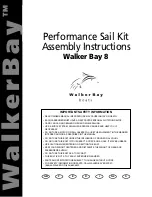
Contents
Safety ........................................................................... 3
Safe Operating Practices........................................... 3
Safety and Instructional Decals ................................. 6
Setup ............................................................................ 9
1 Setting Up the Machine Base Model ........................ 9
2 Installing the Power Harness..................................11
3 Installing the Hopper Extension Kit .......................12
4 Mounting the Hopper to the Tow Chassis ................13
5 Connecting the Intermediate Wire Harness..............13
Product Overview .........................................................16
Controls ...............................................................16
Specifications ........................................................17
Attachments/Accessories........................................17
Operation ....................................................................18
Operating Characteristics ........................................18
Connecting the Machine to a Tow Vehicle ..................18
Turning the Machine Power On/Off.........................18
Setting-up the Machine for Operation .......................19
Operating the Machine............................................22
Wireless Controller Safety (Model 44751
only) .................................................................22
Disconnecting the Machine from a Tow
Vehicle ..............................................................22
Operating the Hydraulic Controls and
Options.............................................................23
Operating the Floor and Option ...............................28
Setting the Preset 1, 2, and 3 Buttons .........................30
Using a Preset Mode ...............................................30
Tow Vehicle...........................................................30
Loading.................................................................30
Unloading .............................................................31
Traveling ...............................................................31
Hills......................................................................31
Parking .................................................................31
Using the Storage Stand...........................................32
Maintenance .................................................................34
Lubrication............................................................34
Daily Checks..........................................................34
Hydraulic System....................................................35
Maintaining the Conveyor Belt System.......................35
Washing the machine ..............................................36
Storage ........................................................................37
Troubleshooting ...........................................................38
Checking Fault Codes (EH Models Only)...................38
Handheld Remote Messages (EH Models
Only) ................................................................39
Safety
Improper use or maintenance by the operator or
owner can result in injury. To reduce the potential
for injury, comply with these safety instructions and
always pay attention to the safety alert symbol, which
means Caution, Warning, or Danger—personal safety
instruction. Failure to comply with the instruction may
result in personal injury or death.
Safe Operating Practices
Training
•
Read the
Operator's Manual
and other training material
carefully. Be familiar with the controls, safety signs, and
the proper use of the equipment.
•
Never allow children or people unfamiliar with these
instructions to use the machine. Local regulations may
restrict the age of the operator.
•
Never operate the machine while people, especially
children, or pets are nearby.
•
Keep in mind that the operator or user is responsible for
accidents or hazards occurring to himself or herself, other
people, or property.
•
Do not carry passengers.
•
All drivers and mechanics should seek and obtain
professional and practical instruction. The owner is
responsible for training the users. Such instruction should
emphasize:
–
the need for care and concentration when working
with ride-on machines;
–
control of a ride-on machine sliding on a slope will
not be regained by the application of the brake. The
main reasons for loss of control are:
◊
insufficient wheel grip;
◊
being driven too fast;
◊
inadequate braking;
◊
the type of machine is unsuitable for its task;
◊
lack of awareness of the effect of ground
conditions, especially slopes;
◊
incorrect hitching and load distribution.
Preparation
•
While operating the machine, always wear substantial
footwear, long trousers, hard hat, safety glasses, and
hearing protection. Long hair, loose clothing or jewelry
may get tangled in moving parts. Do not operate the
equipment when barefoot or wearing open sandals.
•
Evaluate the terrain to determine what accessories and
attachments are needed to properly and safely perform
3



































